Fleur-de-Lis abdominoplasty is a procedure for major weight loss patients, targeting excess and redundant abdominal skin, both horizontally and vertically.
Major weight loss after bariatric surgery or traditional diet and exercise can be a gratifying and life-changing experience. However, as the weight sheds, massive redundant and excessive loose skin can develop, especially on the abdomen and back. This is an unsightly side effect of major weight loss and can cause health and psychological complications.
Book your appointment online now
Treating loose skin resulting from major weight loss can involve less invasive non-surgical solutions or abdominoplasty procedures, which are more effective.
However, many times, adressing massive loose skin tissue can be challenging with traditional abdominoplasty procedures, requiring a specialised approach.
Dr. Bernard’s Approach to Fleur-de-Lis Abdominoplasty
Traditional abdominoplasty involves a horizontal incision across the lower abdomen along the waistline (hip-to-hip). On the other hand, when performing Fleur-de-Lis abdominoplasty I make two incisions: One incision is a hip-to-hip incision, similar to a traditional abdominoplasty, while the other is a vertical incision running along the midline, starting below the ribs and intersecting the horizontal incision just above the pubic area. The extensive incision allows me to target horizontal and vertical skin laxity adequately.
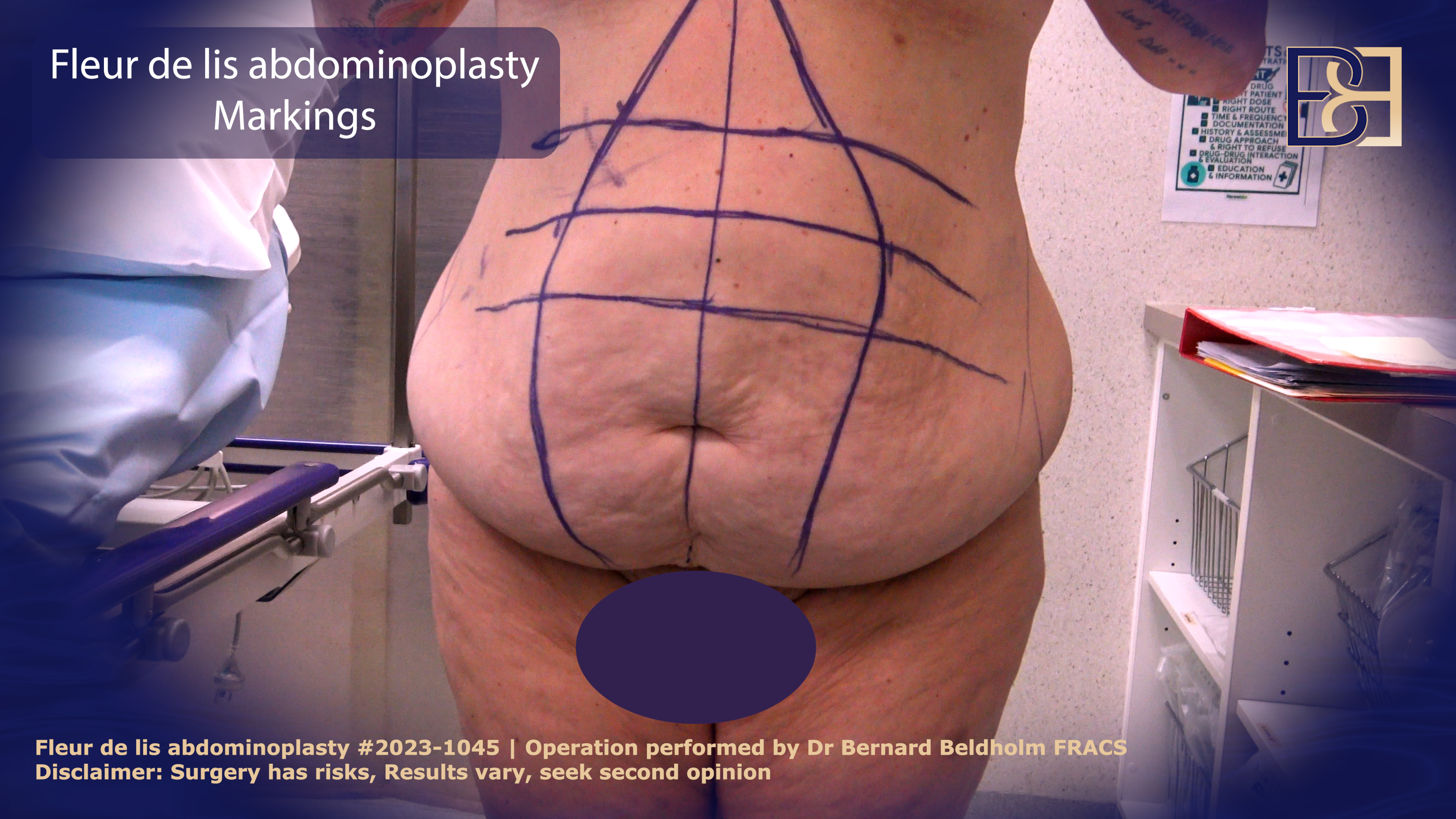
Who is a Suitable Candidate for Fleur-de-Lis Surgery?
If you’ve lost massive weight, resulting in redundant, loose skin tissue in the lower and upper abdomen, sides, and back, you might be the right candidate for Fleur-de-Lis abdominoplasty.
I recommend Fleur-de-Lis abdominoplasty to both men and women with massive skin tissue and fat on the whole abdominal region that has resulted from massive weight loss after bariatric or gastric bypass surgery, diet, or other factors such as multiple pregnancies or age.
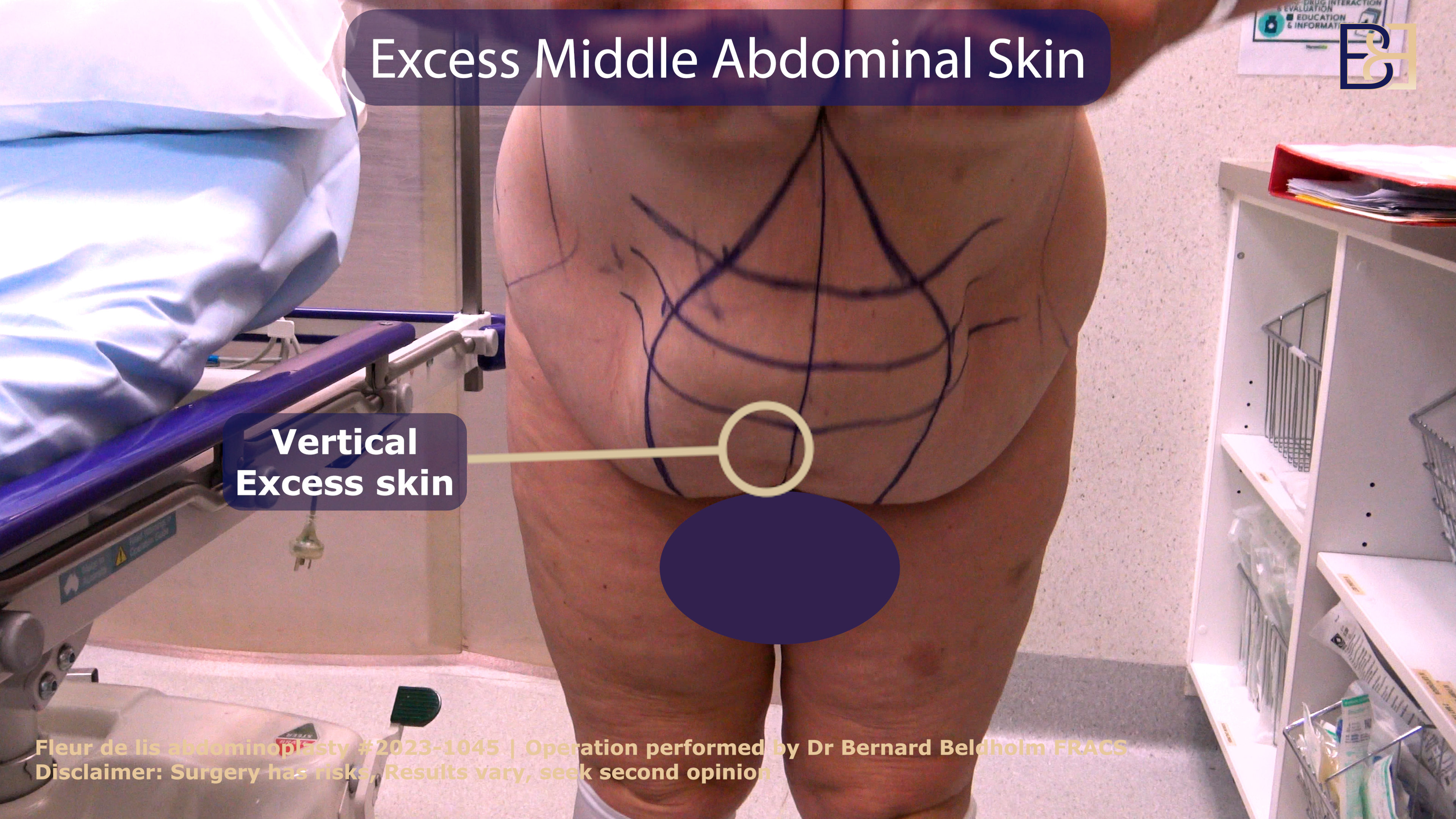
Factors to Consider Before Fleur-de-lis Abdominoplasty Surgery
Every successful surgery starts with a consultation. Whenever you visit my clinic, I will assess a few things to check if you’re a suitable candidate for Fleur de lis.
Suitable candidates will possess the following characteristics:
You have significantly loose skin, both vertically and horizontally, on the upper and lower abdomen, that is challenging to target effectively with traditional abdominoplasty
You are a post-bariatric patients who has lost massive amounts of weight
You have attained your ideal goal weight, and it has remained stable for at least 6 months
You have realistic expectations and understand the associated risks and complications involved with this extensive and invasive procedure
You are in overall good health
You are a non-smoker or are willing to quit smoking for at least 6 weeks before and after surgery
You have tried conventional methods like exercise and a healthy diet to get rid of the loose skin, to no avail
The requirements above act as a guide. However, I advise you to visit my clinic for a one-on-one consultation and further assessment to confirm your suitability.
What Makes Someone an Unsuitable Candidate for Fleur-de-Lis Surgery?
Generally, I will consider prospective patients with these characteristics unsuitable candidates for Fleur-de-Lis abdominoplasty:
You have unrealistic expectations
You are a smoker or are unwilling to quit for at least 6 months before and after surgery
You haven’t attained an ideal and stable weight following weight loss,
You are undergoing the procedure as a means of massive weight loss.
Note: I don’t recommend Fleur-de-Lis or any other abdominoplasty procedure, for that matter, for patients who are doing so to lose weight.
How Standard Tummy Tuck (Abdominoplasty) and Fleur-de-Lis Abdominoplasty Compare
In addition to offering all of the standard abdominoplasty (tummy tuck) procedures, including mini, complete/full circumferential, and extended abdominoplasty, I offer Fleur-de-Lis Abdominoplasty to post-weight loss patients and will incorporate liposuction.
Despite Fleur-de-Lis abdominoplasty having numerous similarities with traditional tummy tuck (abdominoplasty) procedures, several differences exist. In addition to being more invasive and extensive than traditional abdominoplasty procedures, several other differences between an Abdominoplasty and Fleur-de-Lis abdominoplasty exist as well.
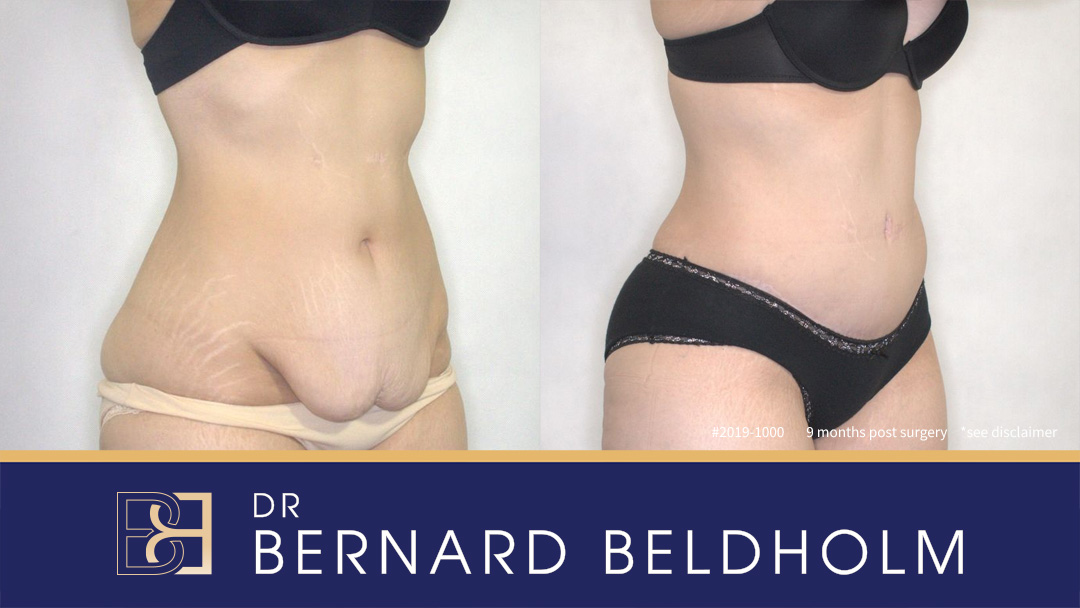
Extended abdominoplasty after massive weight loss.
Disclaimer: Operation performed by Dr Bernard Beldholm. Adult content, surgery has risks; individual results vary, seek 2nd opinion. Please see the full disclaimer.
Choosing between body contouring procedures will depend on several factors, including the amount of skin and excess fat being removed, whether or not repair of muscle separation is required, expected results, and existing abdominal scars. However, one of the primary differences is whether the loose skin is situated both vertically and horizontally or only horizontally.
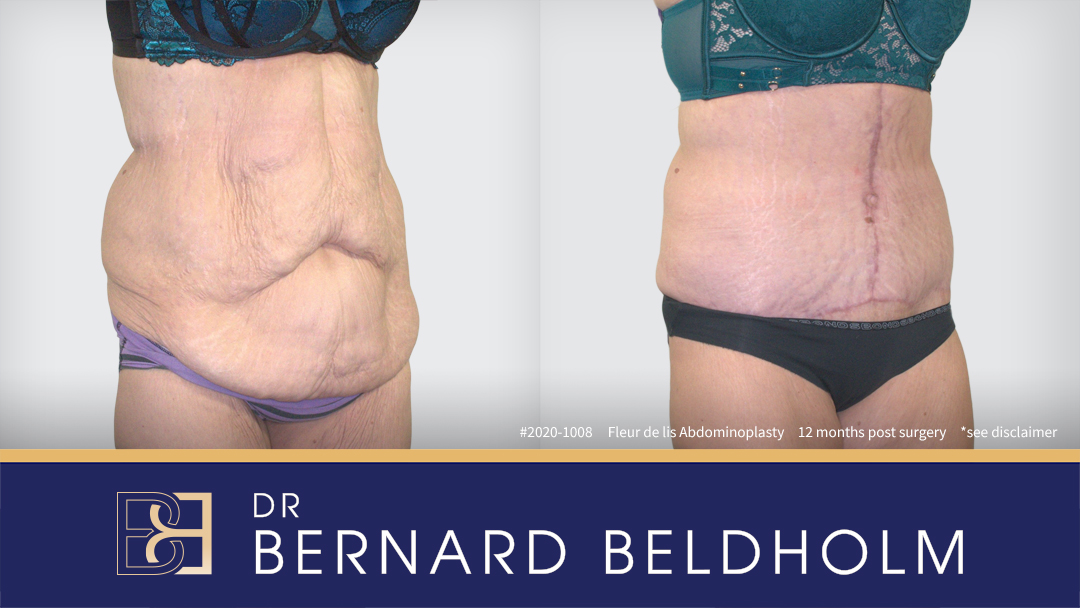
Fleur de lis abdominoplasty after extensive weight loss surgery
Disclaimer: Operation performed by Dr Bernard Beldholm. Adult content, surgery has risks; individual results vary, seek 2nd opinion. Please see the full disclaimer.
To help simplify the comparison between traditional abdominoplasty and the Fleur-de-Lis technique, I’ll focus on the incision, skin and fat removal, and utilisation of pre-existing scars.

Incision
Traditional abdominoplasty involves a horizontal incision across the lower abdomen along the waistline (hip-to-hip). On the other hand, when performing Fleur-de-Lis abdominoplasty I make two incisions: one is a hip-to-hip incision, similar to a traditional abdominoplasty, while the other is a vertical incision running along the midline, starting below the ribs and intersecting the horizontal incision just above the pubic area. The extensive incision allows me to target horizontal and vertical skin laxity adequately.
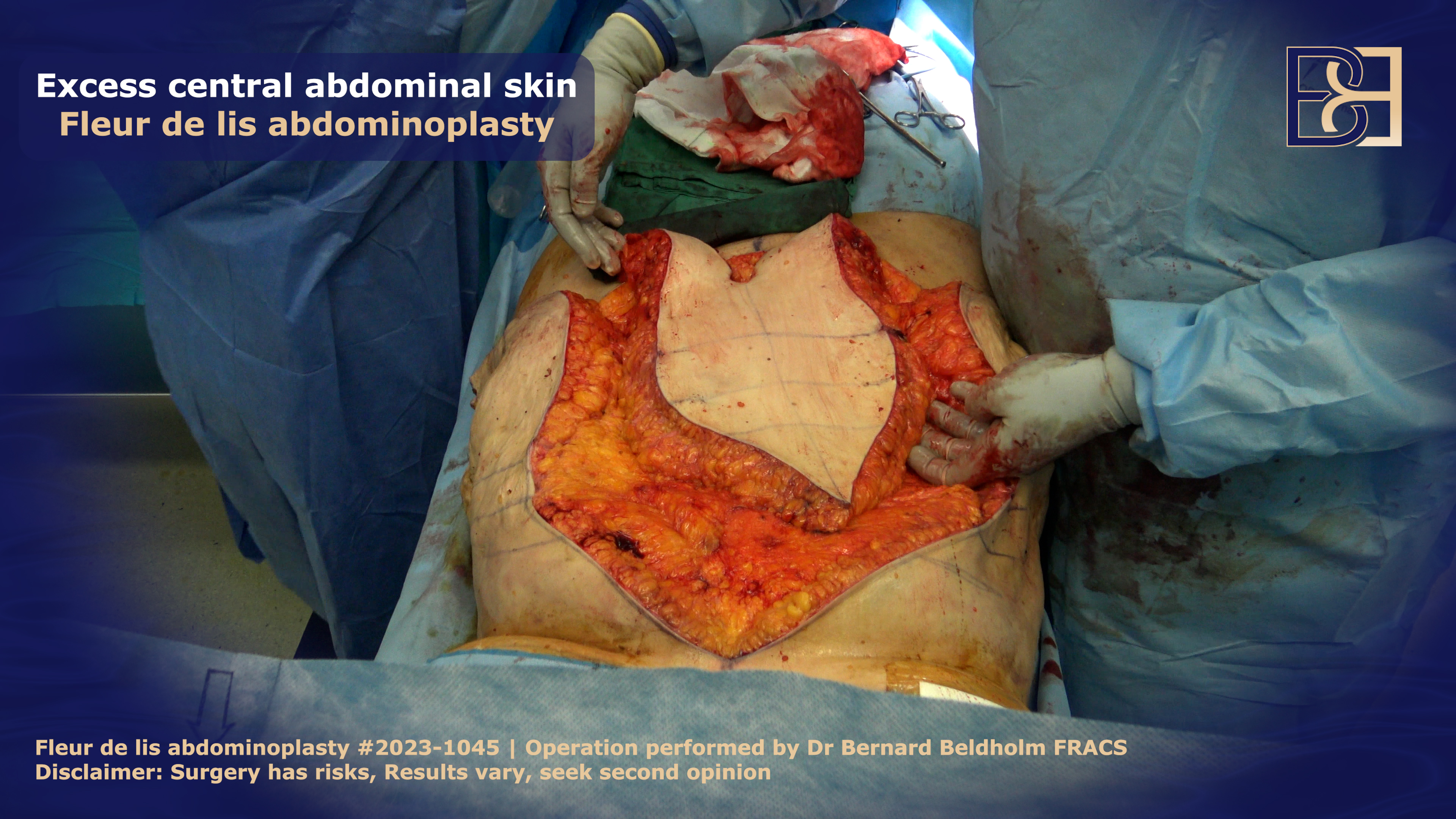
Skin and Fat Removal
Traditional abdominoplasty mainly targets loose skin on the lower abdomen (horizontally), while Fleur-de-Lis abdominoplasty targets skin on the lower and upper abdomen (vertically and horizontally). This makes Fleur-de-Lis surgery suitable for major weight loss patients with massive excess skin, while traditional abdominoplasty is more suitable for those exhibiting only moderately loose skin.
Pre-existing Scars
For patients with pre-existing scars on their upper abdominal region, such as Kocher incision (subcoastal scars) from gallbladder surgery and bariatric surgery scars, Fleur-de-Lis abdominoplasty not only allows me to utilise these scars but allows me to actually helps remove scars in the upper abdominal area, returning normal blood flow to the region.
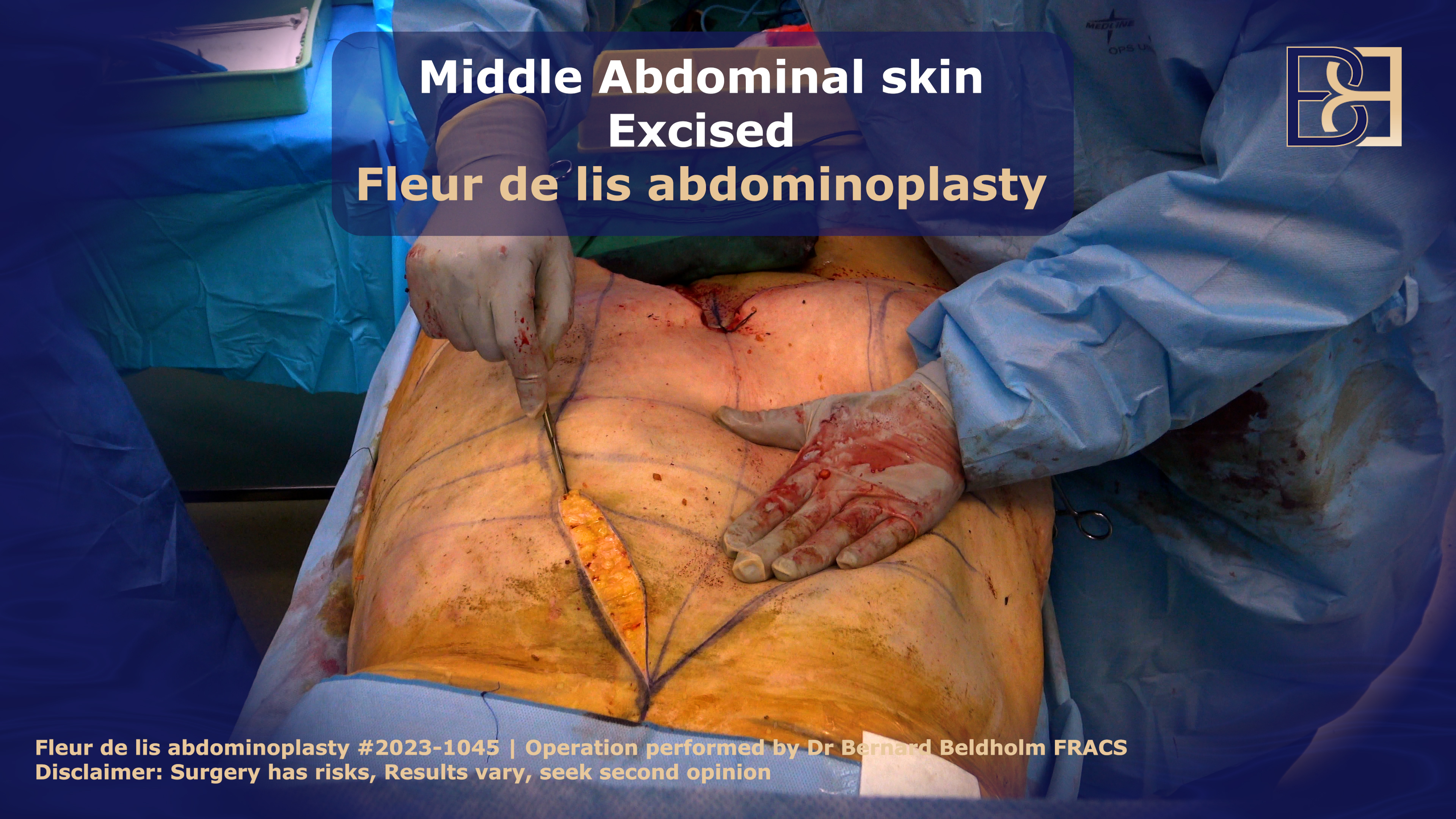
Possible Risks Following Fleur-de-Lis Surgery
Fleur-de-Lis is a major and extensive surgical procedure that poses post-surgical risks. I always discuss potential risks with my patients to ensure they are aware and prepared before surgery.
The common risks include:
Swelling and bruising
Scarring
Asymmetry
Temporary loss of skin sensation
Apart from the risks mentioned above, patients have also experienced the following:
Abnormal scarring: This includes developing thick scars, keloids (scars that extend past the incision region), and hyperpigmented scars
Hematoma and seroma
Skin necrosis and other skin infections
Permanent nerve damage leading to permanent loss of skin sensation
Anaesthetic allergy leading to respiratory complications
Prolonged incision healing
Recurrent skin
Reopening of the incision wound
It is important to note, however, that, according to a recent study published by PubMed, “[f]leur-de-lis abdominoplasty can be performed with complication rates comparable to those of traditional abdominoplasty techniques.”
What to Expect During a Fleur-de-Lis Tummy Tuck (abdominoplasty) Surgery?
Because Fleur-de-Lis abdominoplasty surgery is more invasive and requires extensive incisions, it requires a longer surgery period. At my clinic, the procedure takes approximately 3-5 hours.
Before surgery, you’ll spend some time at the anaesthetic bay, where I’ll take you through the expected process and clarify any last-minute queries. After this, I’ll draw marks on the incision area. The marks show the excision site and act as an incision guide.
While lying on your back on the operating table, anaesthesia is then administered. The surgery starts with me making a standard horizontal (hip-to-hip) incision and a vertical incision along the midline. The extensiveness of the incision will depend on the amount of excess skin tissue to be removed.
After the incisions are made, I then begin to remove the excess skin and fat tissue, reposition the navel, and repair separated abdominal muscles if needed. Lastly, I will close the incision using dissolvable sutures or surgical glue and dress the wound using PICO dressing to reduce wound infection and optimise healing.
Once the wound is closed, I will apply compression garments to reduce seroma, bruising, and swelling. You will be required to continue wearing the compression garment for 4-6 weeks after surgery.

How to Prepare for Fleur-de-Lis Tummy Tuck (abdominoplasty) Surgery
Preparing for a Fleur-de-Lis involves several steps.
Consultation
Before the process begins, the first step is the consultation, which is generally conducted at my Lorn location. During the consultation, I will examine your areas of concern, assess your overall health, and underlying health conditions, as well as discuss your expectations, goals, and concerns. Upon completion of this session, I will be equipped to assess your needs and determine the procedure that will afford you the most successful results.
At this time, I will also inform you of the potential complications and risks, discuss recovery, and review what to expect during and after surgery. I will also address any and all of your concerns and answer all of your questions. We will then provide you with a detailed cost breakdown, review Medicare and/or private insurance coverages, and discuss available.
Pre-surgical requirements
In addition to pre-examinations, I will provide you with a list of requirements necessary for enhancing results and reducing the risk of post-surgical complications.
Quit smoking six weeks before and after surgery
Avoid blood thinners and anti-inflammatory medications
Avoid herbal supplements
Request for time off work after surgery
Arrange for help after surgery and during recovery
Contact our office in the event of illness or changes in overall health
What to Expect Following Fleur-de-Lis Abdominoplasty
Fleur-de-Lis is not an outpatient surgery, so you should prepare to spend a few days at the clinic for monitoring.
After surgery, it is normal and expected to experience intense pain during the first 2-3 days, as well as redness, bruising, and swelling around the incision area. You will be prescribed medication to manage post-operative pain and antibiotics to reduce the risk of wound infection during this period.
During the first week, you’ll be advised to get plenty of sleep and rest, stay hydrated, and avoid strenuous activities. However, I do recommend light walks around the house to increase blood flow.
After 3-4 weeks, you’ll begin to feel like yourself again and can gradually ease back into your normal routine, though you will be required to avoid strenuous activities and exercise until after the 6th to 8th week.
Note that Fleur-de-Lis recovery varies in different patients due to individual factors. Therefore, you should attend follow-up sessions and follow post-operative care.
Advantages and Disadvantages of Fleur-de-Lis Abdominoplasty
Some of the pros of Fleur-de-Lis surgery are:
Repair of separated abdominal muscles (diastasis recti)
Smaller waist
Some of the cons of Fleur-de-Lis surgery are:
Extended recovery period
Extensive scars
Fleur-de-Lis Abdominoplasty Cost Considerations
As the procedure will be customised to fit your individual goals and needs, the cost of Fleur-de-Lis abdominoplasty differs for each patient.
Factors such as hospital and anaesthetic fees, dressing and compression garments, and surgeon’s fees may affect the overall price of the Abdominoplasty procedure, as will additional expenses such as hotel accommodations, time off from work, childcare, and transportation.
Is Fleur-de-Lis Abdominoplasty Covered by Private Health Insurance or Medicare?

In Australia, Medicare covers procedures deemed as a medical necessity and are listed under the Medicare Benefits Schedule (MBS). Fleur-de-Lis abdominoplasty can be deemed a medical necessity since it helps remove excess abdominal skin resulting from a major weight loss and the patient’s health. If left untreated, the excess skin resulting from a major weight loss can cause functional, health, and physiological complications.
Some of the MBS item numbers that cover an abdominoplasty procedure due to major weight loss are MBS item numbers 30175, 30177, and 30179.
Can You Undergo Fleur-de-Lis Surgery After C-Section?
Fleur-de-Lis abdominoplasty after a C-section helps to remove the excess skin and fatty tissue and repair separated abdominal muscles resulting from pregnancy and the C-section. However, I recommend waiting for at least 6 months after C-section before undergoing Fleur-de-Lis surgery to reduce the risks of complications.
Can You Undergo Fleur-de-Lis Surgery After Natural Childbirth?
Just like delivery through C-section, vaginal delivery may also result in diastasis recti. In addition, pregnancy often causes excess skin and fatty tissue around the abdomen. Undergoing a Fleur-de-Lis surgery after natural childbirth will help this. However, I do not advise patients to undergo the procedure immediately after childbirth. Instead, they should wait until full recovery.

Final Thoughts
Fleur-de-lis abdominoplasty is a specialised procedure designed for patients for whom excessive skin on the abdomen, sides and back following major weight loss cannot be adequately with traditional abdominoplasty.
If you’re a major weight loss patient, struggling with loose skin on your lower and upper abdomen, flanks, and back, and it’s affecting your health and functionality, I’d love to set up a consultation to discuss whether Fleur-de-Lis abdominoplasty is right for you.
Book your appointment online now
References
Hespe, G. E., Stepien, D. M., Sherif, R. D., & Gilman, R. H. (2021). Umbilicoplasty in Abdominoplasty: Modifications for Improved Aesthetic Results. Aesthetic surgery journal. Open forum, 3(3), ojab025.
Savva, D., Nittari, G., Gibelli, F., & Vassiliou, A. (2022). Survival of umbilicus on a superiorly based flap after fleur-de-lis abdominoplasty: A case report. Medicine, 101(19), e29115.
Mendes, F. H., Viterbo, F., & Moragas, W. R. (2024). Finesse in Fleur-de-lis Abdominoplasty. Clinics in plastic surgery, 51(1), 81–93.
Ciudad, P., Singhal, D., Sapountzis, S., Chilgar, R. M., Nicoli, F., & Chen, H. C. (2013). The extended fleur-de-lis latissimus dorsi flap: a novel flap and approach for coverage of lower back defects. Journal of plastic, reconstructive & aesthetic surgery : JPRAS, 66(12), 1811–1813.
McKane, B. W., & Korn, P. T. (2012). The fleur-de-lis upper gracilis flap for breast reconstruction: flap design and outcome. Annals of plastic surgery, 69(4), 383–386.
He, J., Qing, L., Wu, P., Ketheeswaran, S., Yu, F., & Tang, J. (2022). Variations of Extended Latissimus Dorsi Musculocutaneous Flap for Reconstruction of Large Wounds in the Extremity. Orthopaedic surgery, 14(10), 2598–2606.
Cohen, J. A., Jaycox, L. H., Walker, D. W., Mannarino, A. P., Langley, A. K., & DuClos, J. L. (2009). Treating traumatized children after Hurricane Katrina: Project Fleur-de lis. Clinical child and family psychology review, 12(1), 55–64.
Mendes, F. H., Donnabella, A., & Moreira, A. R. F. (2019). Fleur-de-lis abdominoplasty and neo-umbilicus. Clinics in Plastic Surgery, 46(1), 49–60.
Friedman, T., Coon, D., Michaels, J., Purnell, C. A., Hur, S. H., Harris, D. N., & Rubin, J. P. (2010c). Fleur-de-Lis abdominoplasty: A safe alternative to traditional abdominoplasty for the massive weight loss patient. Plastic and Reconstructive Surgery/PSEF CD Journals, 125(5), 1525–1535.



